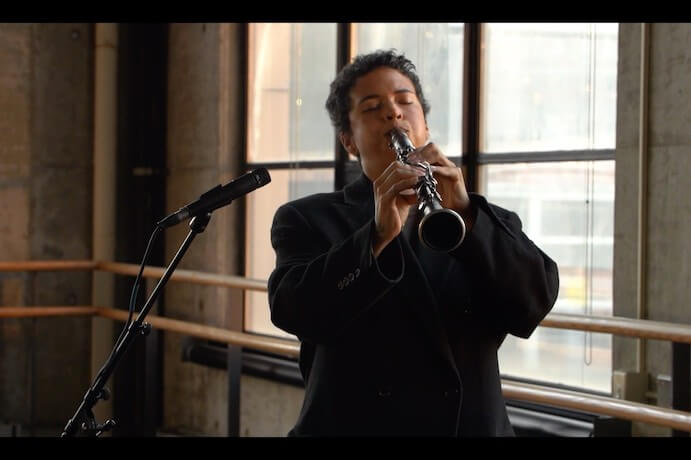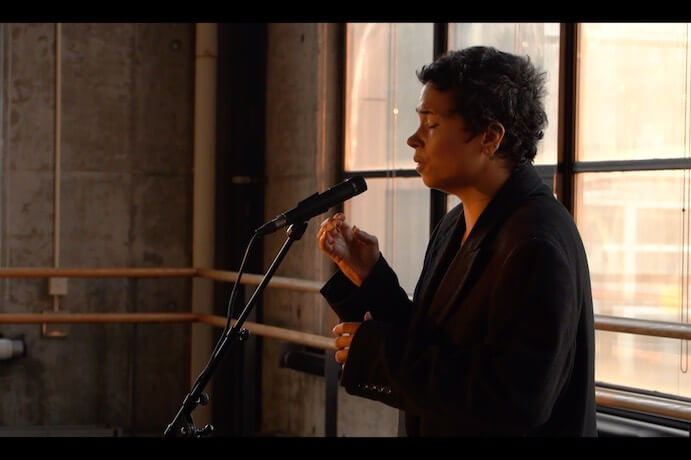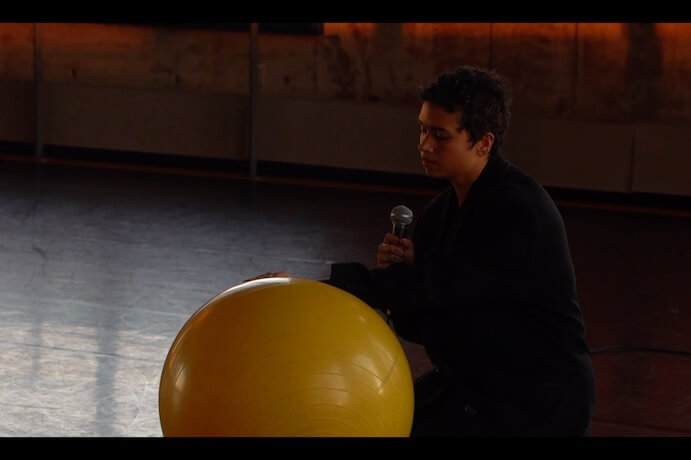There’s a moment in Holland Andrews’ video introduction to Museum of Calm where their brow tenses and they clasp their hands tightly, trying desperately to summon an effective description of their work. It’s a relatable feeling: the futility of attempting to represent deeply personal thoughts and feelings in words. But even before the piece begins, it’s clear to the audience that such futility, or even vulnerability, is not the slightest bit threatening to Holland Andrews—it’s a challenge.
Museum of Calm is Andrews’ latest solo piece, “equal parts vocal music composition, meditation, and performance art.” Commissioned and streamed by Baryshnikov Arts Center, Museum of Calm’s communicative potential hinges on Andrews’ precise delivery through a multitude of media, including videography, clarinet, voice, text, looping pedal, and even movement. Andrews’ artistic goals are lofty: they aim to “convey a total reset from chosen realities and identities, pointing towards a realignment with something that gives craved expansion within a world full of circumstances beyond one’s control.” Museum of Calm crafts a narrative through these emotional abstractions, framed by a few key “characters:”

Holland Andrews Museum of Calm–Screenshot courtesy Baryshnikov Arts Center
Holland as Voice, Holland as Clarinet – With or without words, Andrews themself is the narrative’s central figure. Their singing, speaking, and instrumentals (along with electronics) are the listener’s window into their interior world.
A Microphone: The mic, visible in every shot, is a symbol of Museum of Calm’s inherent digitality. It’s not always the primary mediator of every musical moment, but Andrews’ insistent engagement with and manipulation of the microphone pushes it constantly into the foreground.
A Yellow Ball: Only present at the opening and closing, a cheery, yellow exercise ball is the object that prompts or enables Andrews’ “craved expansion.” Their interaction with the ball at the piece’s bookends demonstrate the endpoints of Andrews’ emotional progression.
Museum of Calm has a rising-and-falling trajectory, nuanced by the characters’ interactions—the first time we see Holland, all three are present. They sit atop the yellow ball, holding the mic, singing, reciting, babbling. But because the text is abstract, even nonsensical, the viewer must rely on other cues to discern a startling shift in atmosphere, from playful experimentation to discomfort. It’s through Andrews’ relationship with these inanimate objects that the viewer finds more concrete meaning, and Andrews’ reactions to the presence of these objects intensify their emotional resonance.

Holland Andrews Museum of Calm–Screenshot courtesy Baryshnikov Arts Center
The sound world is one of gradual but constant change. Despite the repetition of a falling scalar motif, the music never seems still. There is always a sense of building or contracting. In the climactic middle section, for example, the main motif doesn’t so much fall, it avalanches—repetitions and altered restatements roil, topsy-turvy, as Andrews’ live additions to the texture skitter precariously along the surface.
Meanwhile, Tatyana Tenenbaum’s cinematography also has a story to tell. Filmed in the large-windowed John Cage & Merce Cunningham Studio overlooking the cityscape, the intensity of light cast by the setting sun mirrors the trajectory of the music. As the sun moves toward the center of shot, Andrews switches from clarinet to voice; the apex of each cascading figure becomes progressively more pointed and direct. Later, as layers from the tape loop are removed, the natural light vanishes from the studio and Andrews is left increasingly indistinct. Sharp lines and rich, dusky colors are replaced by unsaturated gradients.

Holland Andrews Museum of Calm–Screenshot courtesy Baryshnikov Arts Center
The text is fascinating, if difficult to pin down. While there is no libretto, the listener can pick up on the substitution and recombination of phrases, especially as the text comes into the foreground at the closing. “When I want anything, I wanna feel better,” is sung in seemingly infinite variation, as is, “If I don’t have anything,” “If I don’t need anything,” “If I don’t feel anything,” “How do I feel better.” The mutations continue for minutes on end as the text takes on an obsessive character. The single-minded mantra begins to feel tense, even sick. With the visual (Andrews’ outstretched fingers maintaining tenuous contact with the yellow ball), the “total reset” materializes, and it’s incredibly effective.
Andrews writes that Museum of Calm “generates interior worlds to offer strategies for navigating through chaos, accessing freedom within fantasy, and sustaining the energy required to survive in a reforming society.” In less than twenty minutes, Andrews manages to represent a pandemic’s worth of creative distress and the “realignment” they originally sought to induce. Whether or not Andrews’ catharsis is available audience members looking on, Museum of Calm deserves your attention and reflection.
Museum of Calm is available to stream for free through March 29, 2021 on Baryshnikov Arts Center’s website: https://bacnyc.org/performances/performance/holland-andrews
I CARE IF YOU LISTEN is an editorially-independent program of the American Composers Forum, funded with generous donor and institutional support. Opinions expressed are solely those of the author and may not represent the views of ICIYL or ACF.
A gift to ACF helps support the work of ICIYL. For more on ACF, visit the “At ACF” section or composersforum.org.























